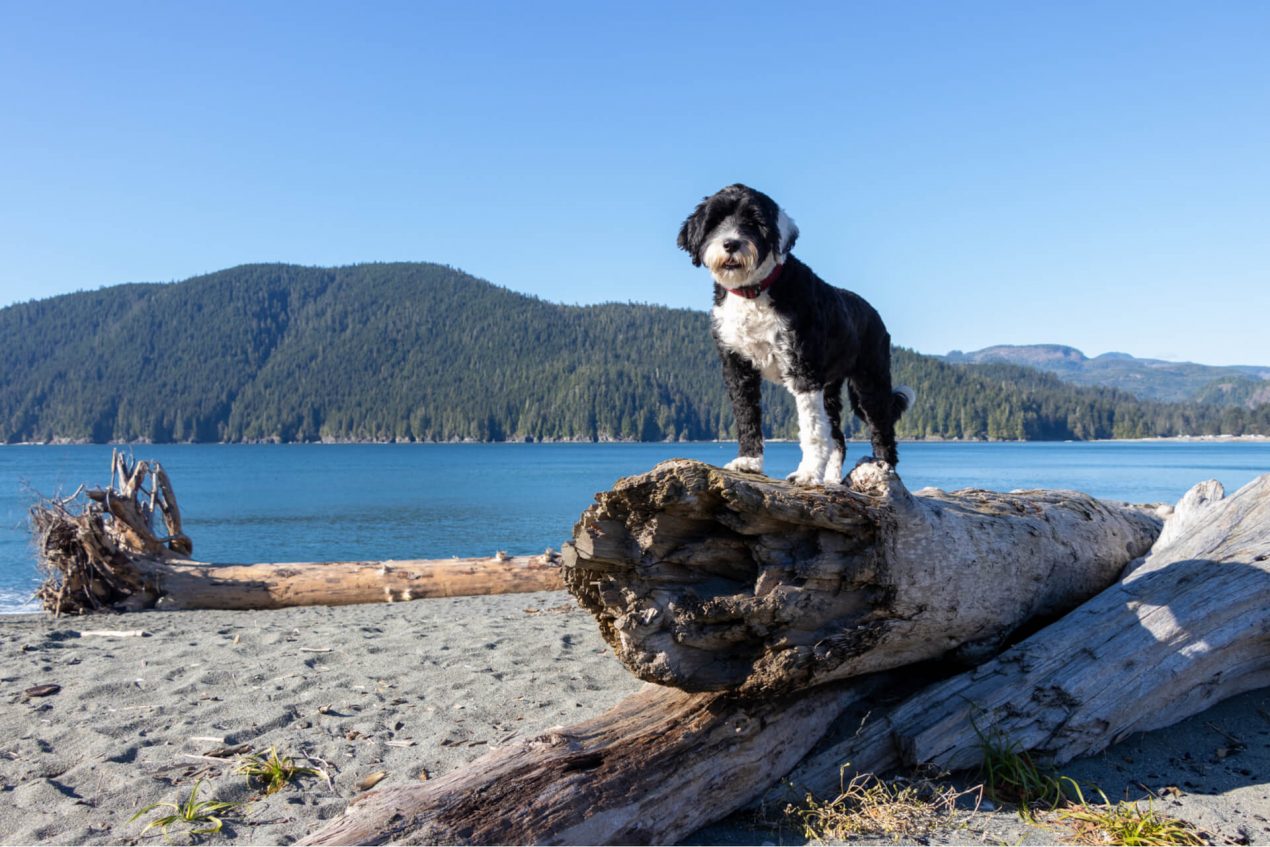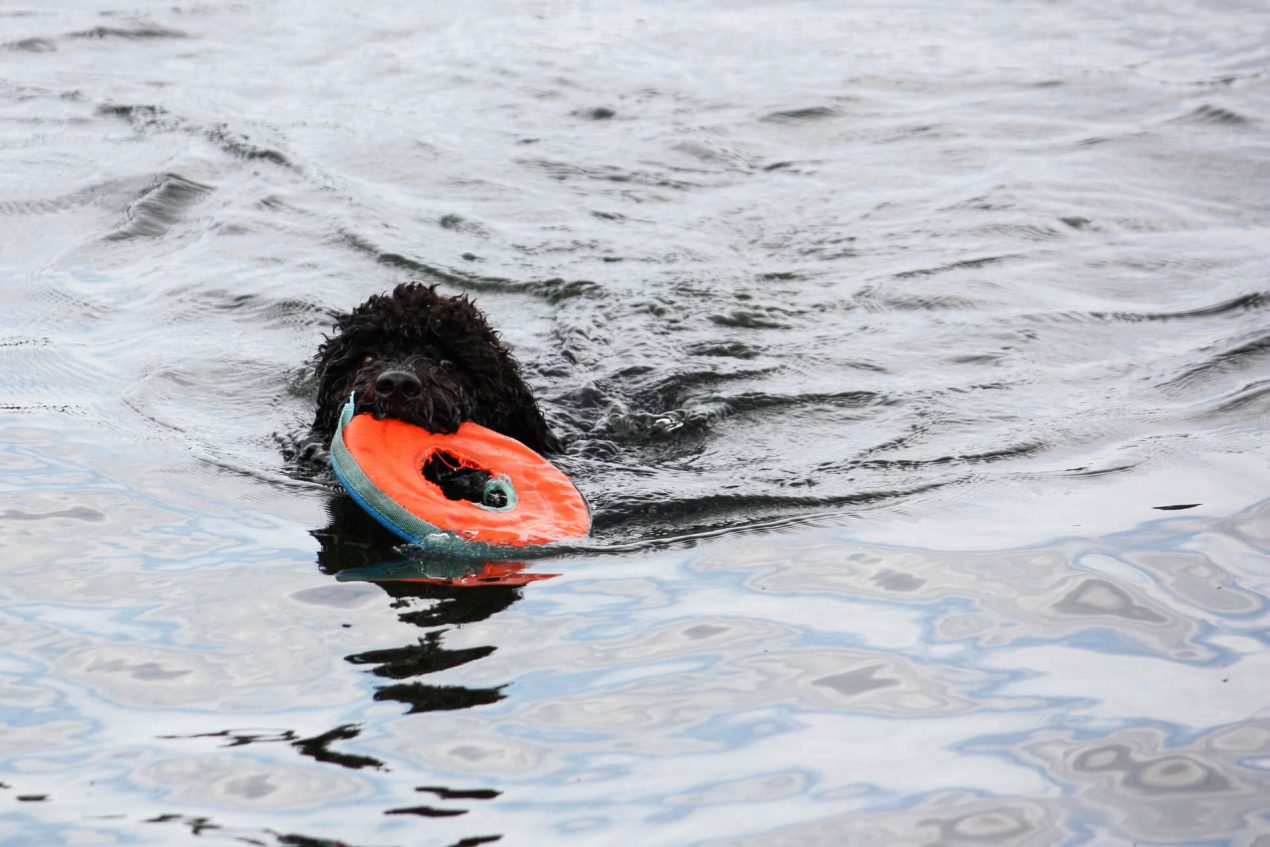The Portuguese Water Dog is not only highly intelligent but also wins hearts with its friendly nature. This medium-sized, elegant-looking breed is not only ideal as a family pet but also known as a true water enthusiast.
History of the Portuguese Water Dog
The Portuguese Water Dog likely originated from a crossbreeding of dogs brought to Portugal by traders and herding dogs already living there. Due to their robustness and great love for water, they were used as messengers between ships in fleets, swimming to deliver messages between them.
They were also used by fishermen – these dogs were employed to bring torn nets back to the boat, retrieve fish from the water, and guard the fishing boat and its catch. Additionally, these loyal four-legged companions rescued many non-swimmers who had fallen overboard.
In the 20th century, the breed nearly died out – technological devices took over their work. Fishermen preferred to rely on these innovations rather than have an additional living being on board that they had to care for and that became useless in old age or sickness. In 1970, the Portuguese Water Dog was recorded as the rarest breed in the world in the Guinness Book of World Records, with only 50 registered specimens.
Later, the water-loving breed experienced a comeback as a family and sports dog; especially in Scandinavia and the United States, the breed is very popular. In America, a significant contribution was made when the then President Obama gifted his daughters a puppy of the breed.
Breed Overview
GROUP: Working
HEIGHT: 42 to 60 pounds (males); 35 to 50 pounds (females)
WEIGHT: 20 to 23 inches (males); 17 to 21 inches (females)
COAT: Wavy or tightly curled
COAT COLOR: Black, black and white, brown; Sometimes white- or silver-tipped
LIFE SPAN: 10 to 13 years
TEMPERAMENT: Intelligent, obedient, companionable, brave, friendly
HYPOALLERGENIC: Yes
ORIGIN: Portugal
Character and Temperament
Known as Cão de Água Português in its native language, the Portuguese Water Dog is considered friendly, attentive, open, and affectionate. When guided with positive reinforcement, they prove to be extremely eager to learn and visibly enjoy working with their owner.
However, the sensitive four-legged friend does not respond well to pressure – Portuguese Water Dogs often react by pushing forward, showing threatening gestures, growling, or even biting when they feel too cornered. For sustainable collaboration with dogs of all breeds, it is advisable to rely on reward through gestures, facial expressions, treats, or a short game and avoid punishments.
| Affection Level | High |
| Friendliness | High |
| Kid-Friendly | High |
| Pet-Friendly | High |
| Exercise Needs | High |
| Playfulness | High |
| Energy Level | High |
| Trainability | High |
| Intelligence | High |
| Tendency to Bark | Medium |
| Amount of Shedding | Low |
Acquiring a Portuguese Water Dog
Since the Portuguese Water Dog was traditionally kept as a working dog and therefore bred for performance, it remains quite active and lively today. Therefore, the breed is not suitable for couch potatoes and dull people – the Cão de Água Português requires regular exercise and also needs mental stimulation, or else it will wither.
Or it will find its own activities: Unpleasant behaviors such as frantic guarding of the house, property, or apartment, solo outings, damaging objects, or self-destructive behavior can be the dire consequences of prolonged under-stimulation.

What to Consider When Buying?
As with all dogs, choosing the right breeder is crucial when bringing a Portuguese Water Dog puppy into your home. The right breeder – one who belongs to a breeding association and is regularly inspected – is essential.
Additionally, they should be able to answer questions about the parent animals comprehensively. If only the mother animal lives with them, it should be able to be visited at any time and without much advance notice, just like the puppies after their birth. Both parent animals should be regularly checked by a veterinarian and also examined for hereditary diseases before being allowed to breed.
In a reputable breeding environment, puppies are socialized from an early age and sensitized to everyday situations, other beings, car rides, loud noises, etc. If neglected, this can result in a serious deficiency for the entire dog’s life – fears and skittishness can develop, which the dog and owner often have to struggle with until the dog’s death.
Development and Training of the Puppy
Young Cão de Água Português puppies are lively, playful, and, like all puppies, full of curiosity. They shouldn’t be left alone for too long – on one hand, they’ll have too much time to get into mischief, and on the other hand, this could lead to significant separation anxiety, making it nearly impossible for them to stay alone later on – for example, during working hours.
To avoid overwhelming the dog, only the most important commands should be practiced and trained in the first year. Sit, down, and stay are completely sufficient – the key is intensive practice with many repetitions to deepen the basic commands. This applies, of course, to recall as well – the most important command throughout the dog’s life. It’s considered the green light for safe off-leash running.
At the age of one to two years, a particularly sensitive phase – adolescence – occurs. Due to hormonal changes, the dog’s brain is sometimes not very receptive, and boundaries are tested. The only solution here is to remain consistent but loving – and never lose your sense of humor and good bond with your four-legged friend!
How to Care for a Portuguese Water Dog?
A Portuguese Water Dog is naturally quite lively and therefore needs a healthy mix of activities and rest. From the beginning, it should be made clear that action isn’t always immediately available when the four-legged friend demands it. Otherwise, you’ll quickly have a very demanding, annoying companion at home who constantly demands play and frolics, even when it’s really not convenient.

Rest must be learned by active dogs just like many other aspects of daily life. It’s best to start this in puppyhood by getting the dog used to a specific retreat area – and then leaving it alone there, which can be difficult for both children and many adults when faced with a cute, cuddly puppy.
Otherwise, the Cão de Água Português is up for almost any fun and loves to be active with its owner – whether it’s playing, hiking, jogging, running alongside a bike, or – due to its breed – swimming and playing in the water.
Activities with the Portuguese Water Dog
Since the Portuguese Water Dog naturally loves water, activities in the wet are particularly popular. Retrieving from the water, being used as a rescue dog, or simply swimming are highly appreciated by the breed. But even on hikes and bike rides, the active animals can exert themselves properly.
Due to their athleticism and high willingness to learn, the large four-legged friends are also excellent candidates for dog sports. Agility, mantrailing, canicross, or dog dancing are eagerly embraced by these active dogs.
Health and Grooming
The Portuguese Water Dog is inherently a very robust dog, with little susceptibility to illnesses. However, the breed was threatened with extinction for a short period of time. All present-day specimens are descended from the approximately fifty remaining animals that existed around 1970.
Due to this rather limited gene pool, unfortunately, there can be an increased occurrence of hereditary diseases – such as Progressive Retinal Atrophy, which can cause blindness in dogs, the heart disease Juvenile Dilated Cardiomyopathy, and also a lipid storage disease called Gangliosidosis are quite common in dogs of this breed. Prevention can mainly be achieved by choosing a good breeder who pre-tests prospective parent animals for the above-mentioned hereditary diseases using genetic testing.
Additionally, the Portuguese Water Dog often suffers, like many other breeds, from hip dysplasia. This can not only be prevented by examining the hereditary conditions but also requires intervention from the owner. To avoid this condition, it is important to start with movement-intensive dog sports only after the dog has reached full maturity at around 18 months of age when the bones and joints are mature enough. Moreover, with puppies, one should always ensure they do not climb stairs too often or make high jumps.
Regarding grooming, it mainly consists of regular, yet necessary and unfortunately quite time-consuming brushing and combing. Cleaning the fur with shampoo is not only unnecessary but also harmful to the dog’s sensitive skin. This type of grooming should only be done in exceptional situations, such as after rolling in manure or similar substances. If the owner prefers, the fur can be clipped similar to a Poodle. Since the Portuguese Water Dog has almost no undercoat despite its fluffy appearance, it sheds very little.
Additionally, regular examination of the claws should be performed to trim them if necessary. Care must be taken not to clip too much of the nail, as this could cut into the quick, which is well vascularized and would be very uncomfortable for the dog.
Interesting and Worth Knowing
The Portuguese Water Dog has developed small webs between its toes due to its work in the water. Show dogs often have elaborate, time-consuming hairstyles. Similar to the Poodle, the so-called “lion cut” is particularly popular. With this cut, the hair is left long at the front like a lion’s mane and shaved short at the back.
Are you considering getting a Portuguese Water Dog, or do you already own one? Share more about it with us in the comments!


